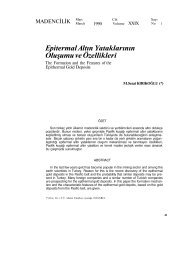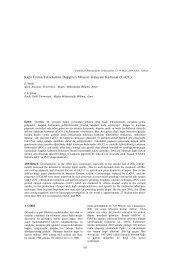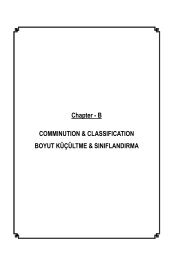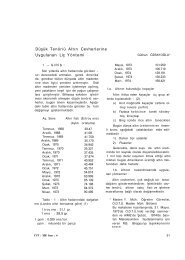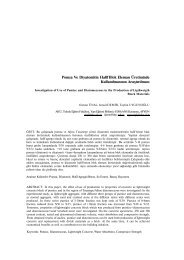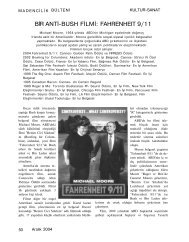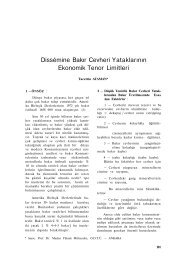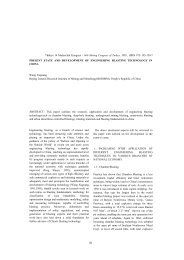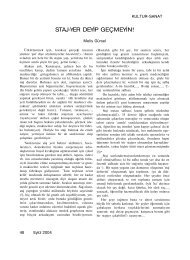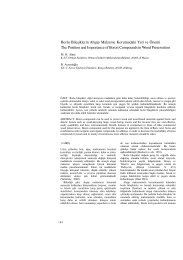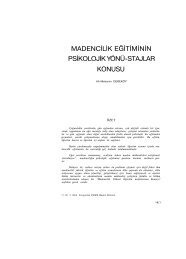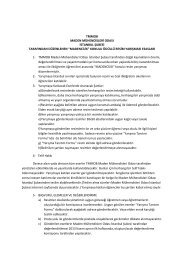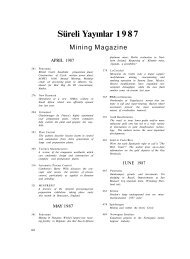A OPEN PIT MINING AÇIK OCAK MADENCİLİĞİ
A OPEN PIT MINING AÇIK OCAK MADENCİLİĞİ
A OPEN PIT MINING AÇIK OCAK MADENCİLİĞİ
You also want an ePaper? Increase the reach of your titles
YUMPU automatically turns print PDFs into web optimized ePapers that Google loves.
M. Coli, M. Baldi<br />
Figure 5. General view of the main Roman<br />
sledge-way driven above the ancient quarries<br />
of the bekhen-stone opened at the base of the<br />
slope.<br />
Then, the collected blocks were dressed in<br />
situ to the right size, because the layering<br />
represents a natural surface of weakness, the<br />
hand worked blocks could break during the<br />
dressing.<br />
The hand worked blocks were not finished<br />
or polished, usually these actions were<br />
completed only at the final destination, so<br />
that the finished surfaces were not damaged<br />
during the transport.<br />
4.1.3 Use<br />
The bekhen-stone is a beautiful grey/green<br />
ornamental stone prized for all kinds of<br />
artistic production. It was already quarried in<br />
the Predynastic period (Nagada I e Nagada II<br />
- Lazzarini 2002), and a large number of<br />
artifacts in bekhen-stone have been found in<br />
pyramids, tombs and temples, many ancient<br />
Pharaohs having had their sarcophagus made<br />
with bekhen-stone (e.g.: Unas, Teti, Pepy I,<br />
Merenre - Old Kingdom) (Aston et al.,<br />
2000). The statue of Darius in Persepolis<br />
was made of bekhen-stone, and the Romans<br />
largely used the bekhen-stone both for<br />
mediatic purpose and for the production of<br />
bowls, statues and sarcophaguses, until the<br />
III Century A.D. (Borghini, 1989; Lazzarini,<br />
2002; Giampaolo et al., 2008).<br />
The quarries were still being worked<br />
during the late Roman times, but with the<br />
decline of the Empire the request for bekhenstone<br />
diminished: many blocks still lie<br />
abandoned along the wadi.<br />
4.2 Breccia Verde Antica<br />
Breccia Verde Antica (breccia verde<br />
d’Egitto) was for the Romans Lapis<br />
hecatontalithos but also Lapis<br />
hexacontalithos (Lazzarini, 2002)<br />
(http://www.museo.isprambiente.it/schedeM<br />
appa.page?docId=381).<br />
We numbered two quarries of “Breccia<br />
Verde Antica”.<br />
4.2.1 - Geology<br />
Breccia Verde Antica was quarried from the<br />
Um Had Conglomerate Member of the<br />
Hammamat Group, it is a dark-, purplishand<br />
greenish-grey to mainly greyish-green,<br />
chloritic siltstone, with a few layers of<br />
pudding (Harrel et al., 2002). This last is a<br />
clast-supported pudding with greenish<br />
chloritic matrix (locally reddish), siltgrained,<br />
with a few levels of well-rounded<br />
sub-spherical pebbly to cobbly (until 25cm<br />
in diameter) clasts of many different<br />
lithologies (granites, limestones, metabasites,<br />
chert, …) and colours (white, pink,<br />
red, yellow, brown, green and grey).<br />
The pudding layers have a bimodal<br />
texture, with the pebbles surrounded and<br />
supported by a coarse- to very coarsegrained<br />
sandy matrix with chlorite, sericite<br />
and epidote plus minor amounts of calcite<br />
and iron oxides. The two main pudding<br />
layers are up to a meter thick, and both were<br />
quarried as “Breccia Verde Antica”.<br />
The lithological layering dips of about 45°<br />
towards East and represents a natural<br />
discontinuity.<br />
The pudding layers are cut by two joint<br />
sets which lie at about 90° to each other, and<br />
trend around E-W and N-S respectively,<br />
lying normally to the layering.<br />
Discontinuities are spaced a few meters apart<br />
and delimit natural blocks some cubic meters<br />
in volume.<br />
4.2.2 - Quarrying<br />
Quarriers used the natural discontinuities as<br />
preferential surfaces to force the block to fall<br />
down, therefore the two quarries were<br />
opened on the northern wadi side where the<br />
14



